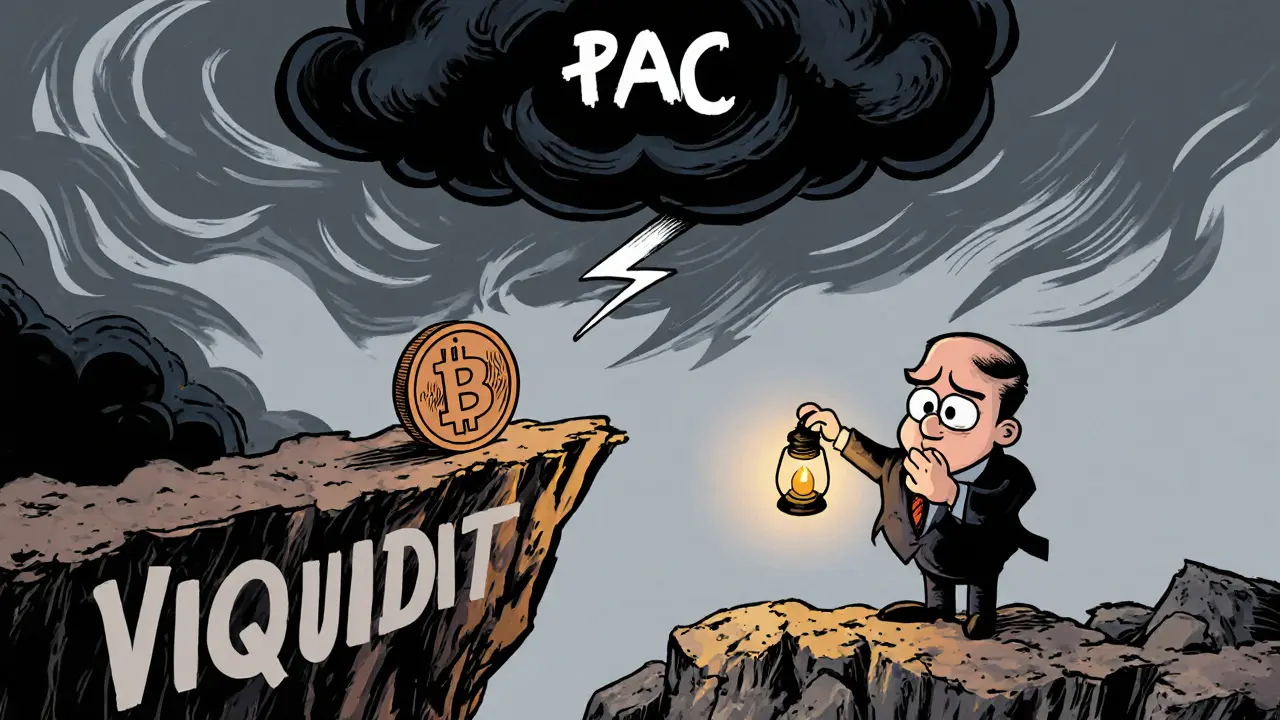PAC Protocol (PAC) Crypto Coin Explained - Price, Tech & Risks

Apr, 14 2025
PAC Token Value Calculator
Current PAC Price: $0.00000345 (as of October 2025)
Market Cap: $60K • Masternodes: 13,000+ • Liquidity: Low
Note: To run a PAC masternode, you need 10,000 PAC tokens (≈ $34.50 at current price).
PAC Protocol is a decentralized cryptocurrency that uses a proof‑of‑stake consensus and a large network of deterministic masternodes. Launched in 2017, the project markets itself as a next‑generation blockchain solution with over 13,000 active nodes worldwide. While its market cap hovers around $60,000 in 2025, the coin remains a niche, micro‑cap asset that many newcomers stumble upon when scanning lists of obscure tokens.
Key Takeaways
- PAC Protocol operates on a dual‑layer PoS + masternode architecture.
- 13,000+ active masternodes make it one of the largest decentralized masternode networks.
- Market cap is under $70K, with daily volume below $600, indicating very low liquidity.
- Acquiring PAC typically requires swapping from BTC or ETH on a handful of exchanges such as KuCoin and Bybit.
- Risks include extreme price volatility, scarce exchange listings, and limited real‑world use cases.
What Is PAC Protocol?
The PAC Protocol PAC coin was founded in the United States in 2017. Its whitepaper promises a blockchain that solves real‑world problems by combining energy‑efficient proof‑of‑stake (PoS) consensus with deterministic masternodes. The project’s leadership includes CEO David Gokhshtein and Chairman Drew Saunders.
According to Holder.io, PAC’s all‑time low price was $0.061431 on October 10, 2017, and its all‑time high reached $0.01888 on March 24, 2021. As of October 23, 2025, the live price trades around $0.00000345, with a 24‑hour range of $0.00000329‑$0.00000374.
Technical Architecture
The protocol runs on a dual‑layer design: a PoS base layer handles block production, while a deterministic masternode layer provides fast transaction verification and additional services such as instant swaps. Below are the core technical components:
- Proof of Stake (PoS): Validators lock PAC tokens to secure the network, consuming far less electricity than Bitcoin’s proof‑of‑work.
- Masternode network: Approximately 13,000 active masternodes worldwide, each requiring a collateral of 10,000 PAC tokens to operate.
- Deterministic node selection: Node rotation follows a predictable algorithm, reducing the chance of centralization.
- Energy efficiency: The PoS model cuts energy use dramatically, though exact consumption figures are not publicly disclosed.
Compared with older masternode projects like Dash, PAC claims a larger node count but has far less market depth and community support.

Current Market Data
Market‑cap estimates vary by exchange. Bybit lists a market cap of $60.13 K, while KuCoin shows $49,572. Trading volume is minuscule: Holder.io records just $545 in 24‑hour volume for the PAC/BTC pair. The token is listed on a handful of platforms, including KuCoin, Bybit, and Graviex, but all suffer from thin order books.
Key metrics (as of August 27 2025):
- Active masternodes: >13,000
- Total supply: ~1 billion PAC
- Circulating supply: ~1 billion (nearly all minted)
- Liquidity: Low - price slippage of 10‑15 % on trades above $50
How to Acquire PAC
Because PAC does not trade on major U.S. exchanges, buying it involves a few extra steps:
- Purchase a base cryptocurrency (BTC or ETH) on a mainstream exchange such as Coinbase or Binance.
- Transfer the BTC/ETH to a wallet that supports token swaps (e.g., Trust Wallet or MetaMask).
- Use a supported exchange - KuCoin, Bybit, or Graviex - to swap the base coin for PAC. You will need to create an account, complete KYC, and deposit the BTC/ETH.
- Withdraw PAC to a secure wallet (e.g., a hardware wallet) that holds custom tokens. PAC follows the BEP‑20 standard on Binance Smart Chain, so ensure your wallet can handle BEP‑20 assets.
Minimum purchase amounts are effectively $10 due to exchange minimums, but for meaningful staking you’ll need at least 10,000 PAC per masternode, which translates to roughly $30 000 at current prices - a prohibitive barrier for most retail investors.
Risks and Criticisms
The crypto community voices several concerns about PAC:
- Liquidity crunch: With daily volume under $600, any sizable order quickly skews the price.
- Extreme volatility: CoinGecko recorded a 16.5 % single‑day drop during a 24‑hour window.
- Limited adoption: No known merchant acceptance, enterprise integrations, or real‑world case studies.
- Sparse community: Reddit’s r/PACGlobalOfficial has just over 1,200 members, and the official Telegram channel sees fewer than 400 active users.
- Development stagnation: The last major code update was in 2021; recent commits are limited to security patches.
These factors place PAC firmly in the high‑risk, speculative category typical of micro‑cap assets.

How PAC Stacks Up Against Similar Projects
| Metric | PAC Protocol (PAC) | Dash (DASH) | PIVX (PIVX) | Horizen (ZEN) |
|---|---|---|---|---|
| Launch Year | 2017 | 2014 | 2016 | 2017 |
| Active Masternodes | ~13,000 | ~5,000 | ~4,000 | ~10,000+ |
| Market Cap (Oct 2025) | $60 K | $1.1 B | $45 M | $140 M |
| Consensus | Proof‑of‑Stake + Masternodes | Proof‑of‑Work (X11) + Masternodes | Proof‑of‑Stake | Proof‑of‑Work + Sidechain Masternodes |
| Exchange Listings | 3‑5 minor exchanges | Dozens, including major | 10+ exchanges | 15+ exchanges |
The table makes it clear that PAC’s node count is impressive, but its market footprint is tiny compared with peers. Investors looking for liquidity and broader ecosystem support typically gravitate toward Dash or Horizen.
Future Outlook
The official roadmap (last updated May 2023) mentions planned privacy upgrades and cross‑chain interoperability, yet no concrete timelines have been shared. GitHub activity shows only minor security patches in the past year, suggesting the project is in a maintenance phase rather than aggressive growth.
Analysts at Delphi Digital warn that micro‑cap tokens with market caps below $100 K face existential risk as exchange listing fees rise and regulatory scrutiny grows. Messari’s 2023 Micro‑Cap Crypto Report estimates less than a 15 % chance that projects like PAC will retain exchange listings beyond 2025.
For now, the most realistic scenario is that PAC remains a niche experiment: a technically interesting masternode network with limited financial upside.
Frequently Asked Questions
What is the main purpose of PAC Protocol?
PAC aims to provide a decentralized, energy‑efficient blockchain that leverages a large masternode network for fast transaction verification and optional privacy features.
How many masternodes does PAC have?
Over 13,000 active masternodes are reported across the globe, making it one of the biggest masternode networks in the crypto space.
Where can I buy PAC tokens?
PAC is listed on a few smaller exchanges such as KuCoin, Bybit, and Graviex. You typically need to swap BTC or ETH for PAC on one of those platforms.
Is PAC a good investment?
Because of its tiny market cap, low liquidity, and limited adoption, PAC is considered high‑risk. It may appeal to speculative traders, but it lacks the fundamentals of stronger projects.
What are the staking requirements for a PAC masternode?
Running a masternode requires locking 10,000 PAC tokens as collateral, plus a reliable server and the technical know‑how to maintain it.